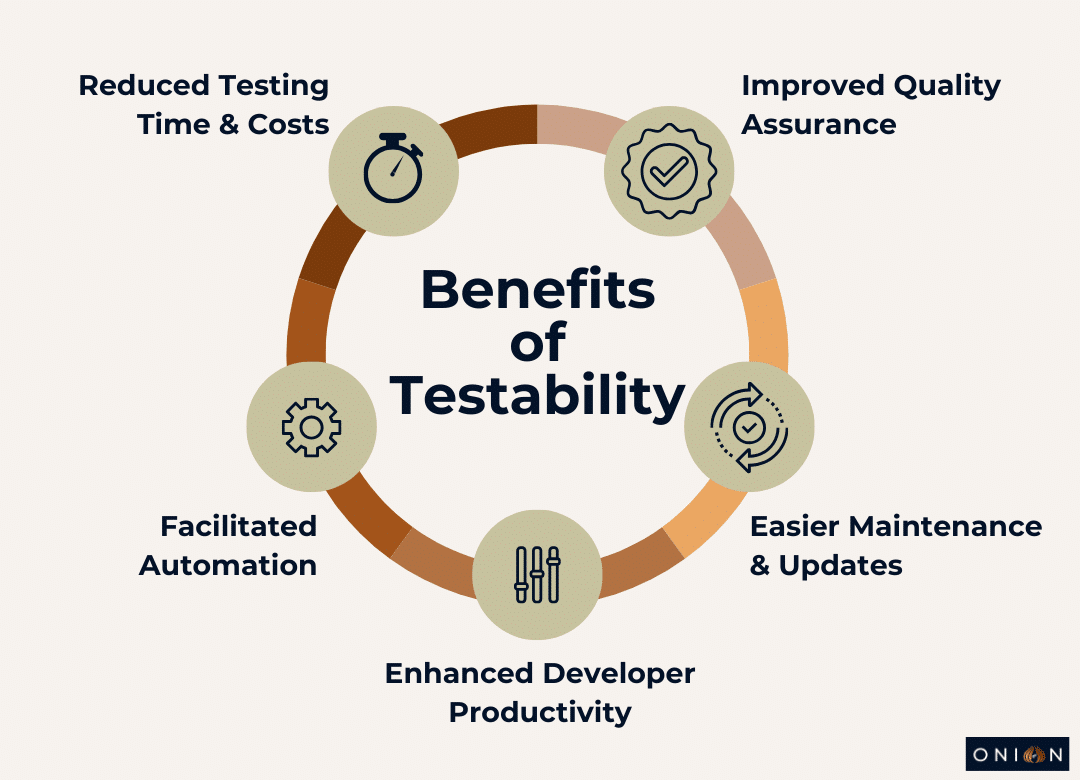In the complex world of software development, one critical aspect that often determines the success or failure of a project is its ‘testability’. Testability refers to how easily software can be tested to detect defects and ensure it meets the required functionality and performance standards. This attribute is not merely a convenience but a fundamental necessity that can significantly affect both the development process and the quality of the final product. But what exactly makes software testable? Why should developers prioritise testability from the outset? In this blog post, we explore the essence of software testability, uncover its pivotal role in software development and illustrate why ignoring it can be a costly oversight.

Table Of Contents
What is Software Testability?
Software testability is a measure of how easily a software system can be tested. It reflects the ease with which test conditions can be created, tests can be executed and outcomes can be evaluated to determine whether a software product behaves as expected. Essentially, testability is about providing a clear pathway through which software can be validated and verified under various conditions, ensuring that it performs reliably in the real world. High testability is closely linked to several factors, including the clarity of source code, the modularity of the architecture and the capability to isolate and observe behaviours during testing.
The Role of Testability in the Software Development Lifecycle
Testability plays a crucial role throughout the software development lifecycle (SDLC), influencing every stage from design and development to maintenance:
1. Design Phase: During the initial stages of design, considering testability can guide the architectural decisions towards more modular and less complex structures. By planning for testability, developers can ensure that each component can be tested independently and integrated smoothly.
2. Development Phase: As software is developed, testability allows for easier debugging and validation of new features. Features that are designed to be testable help in reducing the time and effort needed for troubleshooting and fixing bugs, which enhances the efficiency of the development process.
3. Testing Phase: In the testing phase, testability directly affects the ability to automate tests, replicate test conditions and predict outcomes. High testability means that the software can be tested thoroughly and efficiently, which is vital for identifying and rectifying defects before the software is deployed.
4. Maintenance Phase: Over the lifecycle of the software, maintenance becomes simpler when the software is highly testable. Updates, patches and modifications can be applied with confidence, knowing that the impact of these changes can be easily assessed through testing.
5. Integration and Deployment: Systems designed with testability in mind integrate more seamlessly with other components and can be deployed with fewer operational issues.
Software testability is not just about making testing easier but about enhancing the quality and reliability of software throughout its lifecycle. By embedding testability into the DNA of a project, teams can achieve more predictable results, faster development cycles and software that stands up to the demands of real-world use.
The Importance of Testability
Benefits of High Testability in Software Projects
The advantages of high testability in software development cannot be overstated. Here are some key benefits:
1. Reduced Testing Time and Costs: Software that is easier to test requires less time and fewer resources to ensure its quality. This efficiency reduces the overall cost of testing and speeds up the development process, allowing more frequent releases or updates.
2. Improved Quality Assurance: High testability facilitates comprehensive and effective testing, which increases the probability of detecting bugs and anomalies early in the development cycle. This leads to higher software quality and stability, enhancing user satisfaction and trust.
3. Easier Maintenance and Updates: Testable software simplifies the process of making changes or adding new features. Developers can more easily predict the impact of changes, reducing the risk of introducing new bugs during maintenance.
4. Enhanced Developer Productivity: When software is designed to be testable, developers spend less time debugging and more time on productive development activities. This can lead to more innovative solutions and better use of development resources.
5. Facilitated Automation: High testability often goes hand-in-hand with better support for automated testing, which can drastically reduce manual testing efforts and allow for continuous integration and delivery practices.

Consequences of Poor Testability
On the flip side, the implications of poor testability can be detrimental to both the development process and the software product:
1. Increased Costs and Delays: Software that is hard to test often leads to longer testing cycles, increased manpower requirements and higher costs due to the extended time needed to ensure quality. These factors can delay product launches and updates, impacting market competitiveness.
2. Lower Software Quality: If a software product is difficult to test, it may not be tested thoroughly. This can result in software that is released with bugs, leading to poor user experiences, potential data loss, security breaches and other critical issues.
3. Challenging Maintenance: Poor testability makes it harder to update or modify software without introducing new defects. This can lead to longer downtime, higher costs of maintenance and frustration for both users and developers.
4. Reduced Scalability: As the system grows, poor testability can make it increasingly difficult to manage and test new functionalities or integrations. This can stifle the scalability and flexibility of the software, limiting its ability to adapt to new requirements or technologies.
5. Impeded Adoption of DevOps Practices: Lack of testability can be a significant barrier to adopting modern development practices such as DevOps and continuous delivery, where rapid testing and frequent releases are fundamental.
7 Key Factors Affecting Software Testability

Understanding the elements that enhance or impair software testability is crucial for developers and testers alike. Here’s a breakdown of the key factors that significantly impact the testability of software:
1. Observability is the measure of how easily the internal states of a system can be inferred from its external outputs following a test execution. High observability allows testers to quickly verify whether the software behaves as expected under various conditions, facilitating faster and more accurate defect identification.
2. Controllability refers to the degree to which testers can manipulate the software’s input and operational settings to achieve varied and essential testing scenarios. Software with high controllability enables testers to efficiently explore different test cases and easily reproduce bug scenarios, which enhances the thoroughness of testing.
3. Simplicity in software testability relates to the complexity of the architecture, design and implementation of the software. Simpler systems are generally easier to understand, test and debug. Complexity can obscure underlying issues, making bugs harder to isolate and fix.
4. Stability measures how susceptible the software is to changes over time, particularly how those changes affect existing functionality. Stable software ensures that once a component is tested and passes, it remains reliable without unexpected failures, reducing the regression testing burden.
5. Isolateability is the extent to which individual components of the software can be tested separately from the rest. High isolateability allows for modular testing and pinpointing specific areas for optimisation or troubleshooting, making the testing process more manageable and less error-prone.
6. Understandability is how easily the software’s design and logic can be understood by developers and testers. Understandable software decreases the learning curve for new developers and testers, facilitates quicker onboarding and reduces the likelihood of errors during both development and testing phases.
7. Automatability is the degree to which software testing can be automated using tools and scripts. High automatability not only speeds up the testing process but also reduces the chance of human error, ensures consistency in testing and supports continuous integration and deployment practices.
These factors are interconnected and improvement in one area often enhances others. By focusing on these aspects, development teams can significantly boost the testability of their software, leading to more robust, reliable and maintainable products.
Assessing Your Software’s Testability
To ensure your software meets high standards of quality and reliability, it’s essential to assess its testability regularly throughout the development process. This section outlines practical steps and considerations for evaluating the testability of your software.
Review Software Design and Architecture: Examine the structure and design of your software to identify areas that may hinder testing efforts.
- Check for modularity and component independence.
- Assess the clarity and simplicity of the architecture.
- Ensure that components are loosely coupled and highly cohesive.
Evaluate Code Quality and Documentation: High-quality, well-documented code is easier to understand and test.
- Review coding standards for consistency and simplicity.
- Ensure comprehensive documentation that includes clear, detailed explanations of system behaviour and interfaces.
- Check for up-to-date and accessible documentation that supports testing efforts.
Analyse Test Coverage and Existing Testing Practices: Determine how thoroughly the current tests examine the software and identify any gaps in testing.
- Use coverage tools to identify untested or under-tested parts of the software.
- Evaluate the effectiveness of existing test cases and the integration of automated tests.
- Review test plans to ensure they cover all functionalities and user scenarios.
Assess Testing Tools and Environments: Ensure that the testing tools and environments are adequate to simulate real-world usage and catch potential defects.
- Verify that the test environments closely mimic the production environment.
- Evaluate the effectiveness of the testing tools in use and consider upgrades or additions if necessary.
- Check for the availability and effectiveness of automation tools that support continuous testing.
Feedback Loop and Continuous Improvement: Establish mechanisms to continuously gather feedback and improve testability based on testing outcomes and development experiences.
- Implement a process for regular feedback from the testing team to the development team regarding testability issues.
- Use insights from testing to refine and enhance software design and testing practices.
- Schedule regular review sessions to assess testability and make adjustments as the software evolves.
By following these steps, organisations can systematically evaluate and improve the testability of their software, leading to more efficient development cycles, reduced costs and ultimately, a higher-quality product. Regular assessment not only helps in identifying immediate areas for improvement but also contributes to long-term success by making the software more adaptable to changes and easier to maintain.
Improving Software Testability
Enhancing the testability of your software can lead to significant improvements in development efficiency and product quality. Here are practical strategies and best practices to improve software testability:
Incorporate Testability into Design and Planning: Start considering testability from the earliest stages of software design and planning.
- Use design patterns and practices that favour testability, such as dependency injection and modular architecture.
- Plan for and allocate resources to testing during the project roadmap and sprint planning stages.
Simplify Code and Architecture: Reduce complexity to enhance testability.
- Refactor complex code blocks into simpler, smaller units that are easier to test.
- Avoid deep inheritance hierarchies and prefer composition over inheritance to enhance modularity and testability.
Enhance Observability and Controllability: Make it easier to observe system outputs in response to controlled inputs.
- Implement comprehensive logging and monitoring that can track and record system state and behaviour.
- Provide interfaces that allow testers to easily manipulate the state of the application during testing.
Develop with Testing in Mind: Encourage developers to consider how each feature will be tested as they design and implement it.
- Include developers in the testing process and encourage a culture of quality.
- Use Test-Driven Development (TDD) where tests are written before the code, ensuring that testing considerations drive development.
Use Appropriate Tools and Environments: Equip your team with the right tools to automate and facilitate testing.
- Invest in robust test automation tools that integrate seamlessly with your development environment.
- Ensure that test environments can be easily replicated and managed, ideally through infrastructure as code (IaC).
Regularly Review and Update Testing Practices: Keep testing practices up to date with current technology and methodologies.
- Regularly review and update test cases and testing strategies to align with new features and changes in the software.
- Conduct periodic training sessions for developers and testers to keep them updated on the latest testing techniques and tools.
Foster a Collaborative Testing Culture: Encourage collaboration between developers, testers and other stakeholders to improve testability and product quality. According to Zipdo 57% of the projects that fail are due to communication breakdown.
- Implement peer reviews and pair programming sessions to identify and address testability issues early.
- Encourage open communication channels where testers and developers can discuss and resolve testing challenges together.
By systematically applying these strategies, your team can improve the testability of your software, which in turn will enhance the efficiency of your testing processes and the overall quality of your software products. This proactive approach to enhancing testability is integral to building software that meets the demands of users and thrives in competitive markets.
Challenges in Achieving High Testability
Achieving high testability in software development presents several challenges. Understanding these obstacles and preparing strategies to overcome them can significantly enhance the testing process. Here’s a look at common challenges and ways to address them:
Complex System Architectures
- Challenge: Large-scale systems with complex architectures often have numerous interdependencies, which can complicate testing efforts.
- Solution: Emphasise modular design to reduce dependencies between components. This not only improves testability but also aids in maintaining and scaling the system.
Legacy Code
- Challenge: Legacy systems often lack proper documentation and tests, making it difficult to ensure they meet current quality standards without introducing new bugs.
- Solution: Incrementally refactor legacy code, adding tests as new features are implemented or as bugs are fixed. This gradual improvement can bring legacy systems up to modern testability standards.
Lack of Skilled Resources
- Challenge: The availability of skilled testers and developers who understand both the technical and strategic aspects of testability can be limited.
- Solution: Invest in training and development for current team members to enhance their testing skills. Consider hiring specialised testing personnel or outsourcing to fill gaps in expertise.
Integration of Third-Party Systems
- Challenge: Integrating external systems or third-party services can introduce variables that are difficult to control and test.
- Solution: Use interface testing and contract testing to ensure that both sides of an integration meet agreed-upon standards and behaviours. Mock interfaces can help isolate the system under test.
Time and Budget Constraints
- Challenge: Testing can be time-consuming and expensive, particularly if it wasn’t a priority in the initial stages of development.
- Solution: Advocate for the inclusion of adequate testing phases in the project’s budget and timeline from the outset. Demonstrate how upfront investment in testability can reduce long-term costs associated with post-launch bugs and maintenance.
Cultural Barriers
- Challenge: In some development environments, there’s a disconnect between developers and testers, or there’s a lack of understanding of the importance of testability.
- Solution: Foster a culture that values testing as an integral part of the development process. Encourage collaboration and open communication between developers and testers to build mutual respect and understanding.
Maintaining Testability with Rapid Changes
- Challenge: In agile environments where changes occur rapidly, maintaining high testability can be difficult.
- Solution: Implement practices like continuous integration and continuous testing to keep pace with development. Ensure that test automation is robust and flexible enough to adapt to changes quickly.
Addressing these challenges requires a proactive approach and a commitment to quality at every stage of software development. By recognising and strategically overcoming these obstacles, teams can enhance their ability to deliver highly testable and, ultimately, more reliable software.
As we’ve explored throughout this post, software testability is not just a feature or an add-on; it’s an essential characteristic that permeates every phase of the software development lifecycle. It impacts everything from the ease of debugging and the effectiveness of tests to the overall quality and reliability of the software product. Emphasising testability from the earliest stages of design through to deployment ensures that the final product is not only functional but also robust and maintainable.
Investing in testability pays dividends:
- For developers, it means less time spent on troubleshooting and debugging, more time on feature development and ultimately a smoother development cycle.
- For testers, high testability results in clearer, quicker and more effective testing processes, which leads to more consistent and reliable results.
- For the business, enhanced testability reduces the risk of post-release bugs and costly downtime, leading to higher customer satisfaction and retention.
However, achieving high testability requires overcoming the above challenges. Despite these challenges, the effort to enhance testability is worthwhile, providing a clear path to a more efficient and effective development process and a higher-quality product.
In conclusion, ask yourself not just “Is your software functioning?” but “Is your software testable?” Answering this question affirmatively might very well be the key to your project’s success. Remember, a testable software is a dependable software.
Related Articles
Become A Quality Assurance Tester: 5 Must-Know Tips
6 Benefits of Well-Documented Software Requirements for Successful Projects
16 Undeniable Reasons Why AI in Software Testing Cannot and Will Not Replace Software Testers

